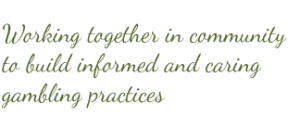RELATIVE RISKS OF GAMBLING
— by Luke MacDonald
Gambling in any form does not come without risk; risk to the individual who is engaging in gambling, as well as risk posed to the greater community. Although gambling behaviors have been present in society for hundreds of years, the broadening accessibility of products and the ease with which individuals can engage with them is becoming increasingly problematic
In order for gambling to reach the level of what would cause these problems, there needs to be frequent exposure.
And because almost everyone in a community is frequently exposed to gambling products, it can be said that almost everyone in a community is at risk of the harms associated with gambling.

There are a number of ways to assess the accessibility of these products; Internet gambling, for instance, is accessible to anyone with a device, reliable Internet connection, and a payment method. Although this is concerning, 80% of gambling continues to happen at in-person venues (Ofori Dei et al., 2020).

While casinos and entertainment venues with VLTs are significant, in-person gambling also extends to include betting on television events among friends, 50-50 draws at sports games, scratch tickets at convenience stores, charity fundraiser lotteries, and even bingo at recreation halls. Each form of gambling has its own set of relative risks and potential for psychological or financial harm, but it has been found that certain settings and certain forms of gambling pose greater risks.
A 2009 study concluded that the number of gambling machines in a venue is closely linked to problematic gambling and therefore, associated risk; it was found that for each additional VLT, the risk of individual harm increased by 8% (Storer et al., 2009). Similar investigations have found that individuals who live within 15km of a gambling venue, or have frequent exposure to gambling outlets (such as casino employees and convenience store workers), are also at increased risk of being negatively affected by gambling harms (Ofori Dei et al., 2020).
When it comes to the different types of gambling, it is also important to assess who is at greatest risk. A 2020 study that grouped individuals into groups of differing gambling patterns found that groups of individuals who gambled at least monthly, in any form, had a higher proportion of gambling-related problems. Involvement with multiple outlets of gambling were also positively related to intensity of the gambling activity. It is important to note, however, that some individuals who only engaged in 1-2 forms of gambling were also greatly affected by associated risks (Mazar et al., 2020).
This leads us to interpret that individuals who gamble infrequently, or those who only engage in some forms, are still at risk of the potential harms that accompany these activities.

It is true that many, if not most, adults participate in some form of gambling or another. However, for some, gambling can lead to impairment on an individual level in terms of health or social functioning, as well as on a larger scale in terms of occupational or financial domains.

Some individuals in society are more vulnerable to these risks than others; adolescents and young adults, for example, which is often attributed to the lack of development in areas of cognitive functioning like judgment and decision-making during the younger years.
Those who align with traits that are described as impulsive, antisocial, and emotionally vulnerable have also proven to be more susceptible to risks associated with gambling (Potenza et al., 2019).
Other factors, such as differences in sex, socioeconomic status, race, and comorbid diagnoses have also been implicated in the assessment of relative risk. One can easily imagine the variation in harms associated with problematic gambling in these individuals; firstly, the financial consequences of gambling, having to gamble with increasing amounts of money in order to achieve the desired satisfaction, can have devastating effects on individuals, families, and businesses.
Much like individuals who become dependent on addictive substances, the act of gambling activates the same neurobiological structures and encourages the same thrill-seeking behaviors that cause individuals to continuously increase the dose, or in this case, amount of money invested into a gambling product, in order to achieve the same effect.

The mood and mental health of individuals who engage in gambling can become affected, as efforts to cut down on gambling following undesired outcomes often leads to irritability or restlessness, as well as persistent and troubling thoughts of past or future gambling experiences. Individuals who turn to gambling as a form of coping with distress often experience social isolation and fractured interpersonal relationships as a result of their habits or financial instability (APA, 2013). Aside from relationships, careers, education, and other responsibilities can also become jeopardized when individuals engage in problematic gambling behaviors, thus enhancing the ‘ripple effect’ that gambling can have on a larger scale.

Some forms of gambling pose different risks than others; VLTs and slot machines, for example, are defined as a ‘continuous’ form of gambling. The time between paying and payout is short, and because winning is not an infrequent result, the reward thus reinforces individuals to continue.
It is also true that many VLTs are located in an environment in which alcohol is served, a substance that is known to impair judgment and adversely affect one’s assessment of potential consequence.
This differs from gambling activities like 50-50 draws and lotteries because of the longer time interval between wager and payout, lower likelihood of reward, and therefore less reinforcement to continue.
It is evident that gambling is not a direct cost-benefit relationship between the person who gambles and the organization that is orchestrating the gambling outlet. Harms, risks, and negative implications frequently and substantially affect the individual, their relationships, and their communities – in a way that can have destructive consequences for all.
REFERENCES
Storer, J., Abbott, M., & Stubbs, J. (2009). Access or adaptation? A meta-analysis of surveys of problem gambling prevalence in Australia and New Zealand with respect to concentration of electronic gaming machines. International Gambling Studies, 9(3), 225–244. https://doi.org/10.1080/14459790903257981

